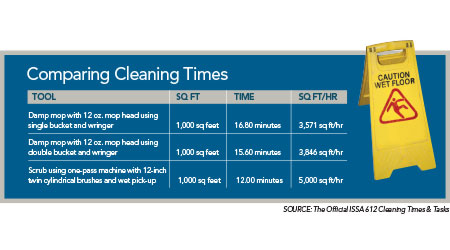
Most compact floor machines are designed with the user’s comfort in mind: They are easy to operate, and alleviate the manual scrubbing that can often lead to worker fatigue or injury.
“With a microscrubber, you’re saving on the strenuous back and forth motion of your mop,” notes Bryan. “It runs at waist height and you just walk behind it while it releases the solution, scrubs it into the floor, and vacuums up the chemicals and soil — all in one fell swoop.”
Cadell concurs: “Your floor gets cleaner, and now you have a happier employee because a lot of the strain that comes with traditional wet mopping is gone. So you’ve provided better ergonomics to the employee, which increases the level of clean in a facility.”
However, the microscrubber’s price tag can be a hurdle for some facility executives — especially those who still rely on a mop and bucket.
“Sometimes people can’t see beyond the price of the microscrubber versus the mop and bucket, so they need to have an open dialog with their distributor,” says Schneringer.
In addition to calculating the return on investment, distributors can help facilities realize the intangible benefits of microscrubbers — cleaner, safer facilities; satisfied employees and occupants; and a positive perception of their business.
“People see a mop that costs five dollars, so they have someone mop the floor, but the floor’s not really clean,” says Bryan. “If a guest walks into a restaurant and the floor is dirty, they start wondering if the kitchen is dirty, too. But if the floor is clean, they don’t think about it. And ultimately that’s what you want.”
KASSANDRA KANIA is a freelancer based in Charlotte, North Carolina.
Choosing The Right Floor Machine

 The Down and Dirty on Cleaning in Virus Season
The Down and Dirty on Cleaning in Virus Season How Surfactant Use is Expanding in Commercial Cleaning
How Surfactant Use is Expanding in Commercial Cleaning Maximize Your Margins: Learn How to Automate Pricing and Track Rebates
Maximize Your Margins: Learn How to Automate Pricing and Track Rebates